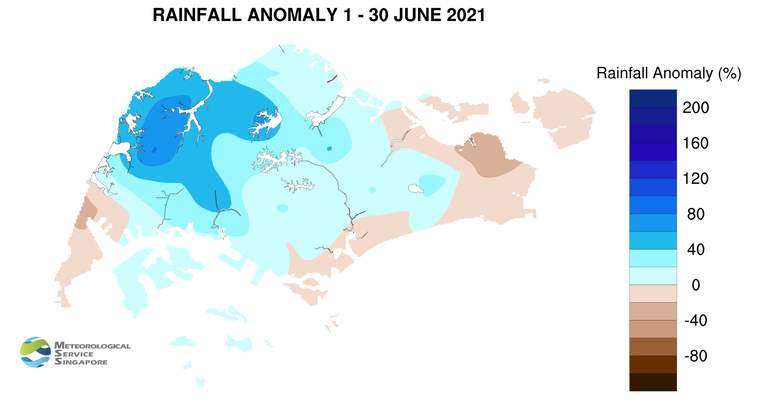Singapore, 1 July 2021 – The prevailing Southwest Monsoon conditions are forecast to persist over Singapore and the surrounding region in July 2021. In the coming fortnight, the low-level winds are expected to continue blowing from the southeast or southwest, and the monsoon rain band is forecast to lie over the equatorial Southeast Asia region. This is expected to bring more showers over Singapore compared to the last fortnight of June 2021.
2 In the first week of July 2021, short-duration thundery showers are expected mostly between the morning and early afternoon. On a few of these days, prevailing winds in the region are forecast to converge over Singapore and the surrounding vicinity. This may influence the development of Sumatra squalls and bring widespread thundery showers and gusty winds over Singapore between the predawn hours and morning. In the latter half of the fortnight, localised short-duration thundery showers can be expected on most days due to strong day-time heating of land areas. Overall, the rainfall for the first half of July 2021 is expected to be near normal over most parts of the island.
3 During the fortnight, the daily temperature on most days is forecast to range between 24°C and 33°C. There can be a few warm days, particularly in the latter half of the fortnight where the maximum temperature could reach around 34°C. On a few nights, warm and humid conditions with night-time minimum temperatures of 28°C can be expected when prevailing winds from the southeast or south blow warm and humid air from the sea.
4 For updates of the daily weather forecast, please visit our MSS website (https://www.weather.gov.sg), NEA website (www.nea.gov.sg), or download the myENV app.
REVIEW (1 – 30 June 2021)
5 Southwest Monsoon conditions prevailed over Singapore and the surrounding region in June 2021. During this period, the low-level winds blew mostly from the southeast or southwest.
6 During the month, short-duration thundery showers fell over parts of the island mostly between the late morning and early afternoon. On a few days, the eastward passage of Sumatra squalls from the Strait of Malacca to the South China Sea brought thundery showers and gusty winds over Singapore in the early morning and in the night. On 29 June 2021, convergence of prevailing winds over Singapore and the surrounding region brought a few spells of thundery showers over many parts of the island in the morning, afternoon, and again in the night. The highest daily total rainfall recorded that day was 134.4mm at Pasir Panjang. This was the highest daily total rainfall for June 2021.
7 June 2021 was a generally warm month. There were 17 days where the daily maximum temperature across the island was above 34°C. The highest daily maximum temperature of 35.5°C was recorded at Marina Barrage on 4 June 2021. There were several warm nights in the first half of the month where the minimum night-time temperatures ranged between 28.0°C and 29.2°C, particularly over the southern parts of the island. The lowest daily minimum temperature recorded in June 2021 was 22.1°C on 13 and 29 June arising from spells of thundery showers that fell throughout most parts of the day and night.
8 In June 2021, rainfall was above average over most parts of Singapore. The highest rainfall anomaly of 84% above average was recorded at Lim Chu Kang. The anomaly was lowest at Changi at 31% below average.
CLIMATE STATION STATISTICS
Long-term Statistics for July
(Climatological reference period: 1991 – 2020)
| Average daily maximum temperature | 31.4 °C |
| Average daily minimum temperature | 25.4 °C |
| Average monthly temperature | 28.2 °C |
| Average rainfall | 146.6 mm |
| Average number of rain days | 14 |
Historical Extremes for July
(Rainfall since 1869 and temperature since 1929)
| Highest monthly mean daily maximum temperature: | 32.4 °C (1997) |
| Lowest monthly mean daily minimum temperature: | 22.9 °C (1975) |
| Highest monthly rainfall ever recorded: | 527.3 mm (1890) |
| Lowest monthly rainfall ever recorded: | 12.2 mm (2019) |

